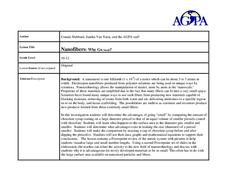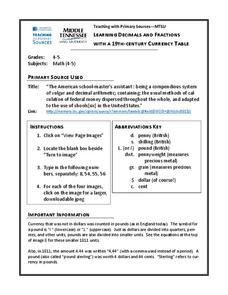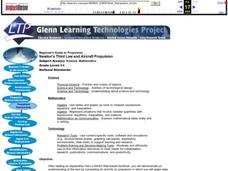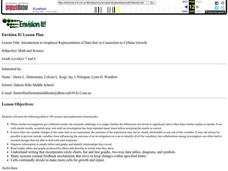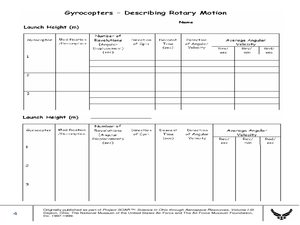Curated OER
Tukutuku Patterns
Students complete a series of lessons involving Tukutuku patterns, their rotations and area formulae. They determine the algebraic formulae for sequences. They use images as they work through the lessons to find the number of crosses in...
Curated OER
Nanofibers: Why Go Small?
Young scholars explore the surface ratio of an object. In this surface area to volume lesson students construct a data table, make calculations and create a graph.
Curated OER
Decimals and Fractions
Young scholars learn about using decimals and fractions by referring to a 19th century currency table. In this decimals and fractions lesson plan, students discuss converting pounds to coins and how they relate to fractions and decimals.
Curated OER
The Old Chicken Run Problem
Sixth graders apply problem solving strategies to work with a real life situation in which they need to determine the area. They determine the area of chicken runs that are rectangular in shape when give a partial perimeter.
Curated OER
Square Milk Bottle Crates
Students attempt a problem that Students has the potential to have more than one solution. Hence the problem is accessible to a wide range of students. The problem is essentially about finding patterns and this is typical of a number of...
Curated OER
Polygonal Strings
Sixth graders apply knowledge of how to calculate the area and perimeter of triangles. They determine why it is inappropriate to measure the area of land by its perimeter which is done in certain areas of New Guinea. They complete a...
Curated OER
Pizza Toppings 2
Students explore possible combinations of items. They devise and use problem solving strategies to explore situations mathematically. They examine using linear and quadratic patterns to solve combination problems. From a given...
Curated OER
Global Water Cycle & Heat Flow
Students experiment to discover how different variables affect the water cycle. They do hat flow experiments and construct a computer heat flow model.
Curated OER
Newton's Third Law and Aircraft Propulsion
Students research propulsion, graph data, and interpret the results.
Curated OER
Kidney and Related Concepts
For this kidneys worksheet, students review the function of the kidneys including what happens when the kidneys stop working. Students also compare kidney function in fish, frogs, and kangaroo rats. This worksheet has 86 fill in the...
Curated OER
When Things Heat Up
Ninth graders investigate relationship between the temperature and concentration of dissolved oxygen in water. They examine how pollution and other natural influences can cause the parameters to change. In groups, 9th graders collect...
Curated OER
Making Rectangles
Students study rectangles. In this math lesson, students use numbers, measurements and geometry to draw rectangles of varying sizes.
Curated OER
Impossible Graphs
Students distinguish between possible and impossible graphs of functions, and to learn why some graphs are impossible. They have practiced plotting functions on the Cartesian coordinate plane
Curated OER
Growing a Garden
Students research aspects of gardening including nutrition, costs, and soil preparation. They then write a report detailing the planning of the garden and compare costs to buying the items.
Curated OER
Investigating Motion
Students determine velocity using the slope of a time distance graph. They investigate a motion cart using a CBR unit and a TI 83 calculator setup. Using the graph generated, they calculate velocity.
Curated OER
Introduction to Graphical Representation of Data Sets in Connection to Cellular Growth
Students practice graphing relationships between variables by studying topics such as exponential growth and decay. They conduct a series of numerical experiments using a computer model and a variety of physical experiments using mold,...
Curated OER
A Solar Project
Students make predictions about the global temperature of the earth and to see how this is dependent upon a number of variables. Students visualize how changing parameters can impact the global temperature of the earth.
Curated OER
Sugar Bush Sap Production - Human Environmental Impact on Sap Sand
Eleventh graders compare the amount of sugar sand present in tree sap. In this environmental science instructional activity, 11th graders measure different tree circumference. They prepare a report and share findings in class.
Curated OER
Gyrocopter - Describing Rotary Motion
Pupils calculate angular displacement, velocity and acceleration of gyrocopters. In this physics lesson, students compare data taken from 3 different gyrocopters. They explain how differences in construction material affect rates of...
Curated OER
Astronomical Scales
Students describe the different units of measurement. In this space science lesson, students calculate astronomical distances using a scale. They explain the significance of using scientific notation in expressing very small or very...
Curated OER
Electroplating for Corrosion Protection: Redox in Action
Learners define what a redox reaction is. In this chemistry activity, students electroplate some wires in the lab. They research the application of electroplating in the real world.
Curated OER
The Genetics of Antibody Diversity
Students distinguish between the light and heavy chain sections. In this biology lesson, students simulate the DNA splicing process. They calculate antibody diversity using the information given.



